Haines, Edward (McKechnie Section 1)
Recorded as E. Haines by Jackson (The History of Silhouettes). It has recently been discovered by Mr J. N. Allen, of Brighton Public Libraries, however, that the artist's first name was Edward. A trade label on the reverse of a silhouette in the Victoria and Albert Museum, London, tells us that the artist was a freehand cutter, and the son of another E. Haines, who was not a silhouette artist. Both father and son worked in their different capacities, in Brighton, on the Pier. On this label Haines' father calls himself 'Proprietor of the Original Weighing Machine', and continues Patronized by the late Duke of York, the Dukes of Clarence and Cambridge, and H.R.H. the Duchess of Gloucester'. In view of the reference to the Duke of Clarence (not to William IV) this label must have been in use before 1830. Equally, Haines' father must have been working his Weighing Machine on the Pier before 1827, when the Duke of York died. Therefore, the label must have been first in use after 1827 and before 1830.
Despite their references to the Original Weighing Machine, two other trade labels (Nos 2 and 3) must refer to Edward Haines the Younger, who presumably inherited the machine on his father's death (and also, incidentally, extended his activities by hiring out pleasure boats).
In 1830 J. Gapp (q.v.) drew attention on his Trade Label No. 2 to the fact that he had no connection with any other person (that is, any other silhouette artist) on the Pier. This also indicates that Haines was in practice before 1830. His father had probably established himself on the Pier with his weighing machine soon after the opening of the Pier in 1823. He may have died or retired sometime in the 1830s.
Directory entries, referring to 'Edward Haines', add a little more information; since they all date from after 1840, one can assume that they refer to the silhouette artist, who (as will be seen) was still in Brighton in 1896. The Brighton Directory and Kelly's Directory of 1845 list 'Edward Haines, the Chain Pier'. Forthorp's Directory of 1848 lists 'Edward Haines, Tower 7 on the Chain Pier'. This entry is repeated annually in directories up to 1859. There is no further reference to Haines until 1895, when Leppard's Brighton Directory lists 'Edward Haines, 2 Devonshire Terrace.' This entry is repeated in 1896. Mr Allen has informed me that, after 1859, Tower 7 on the Pier remained empty. Haines may have moved to a different tower, for Jackson states (Dictionary) that a writer named Bishop, referring to the Chain Pier in 1897, recorded that 'the old Tower Keeper, Mr Haynes, a skilful silhouette cutter, was very deaf, and that his invariable reply to any question was "Is. 6d. head and shoulders, 2s. 6d. full-length
There is also a reference to a Haines (again presumably the silhouette artist) in the Memorial Pamphlet (1896) on the Brighton Chain Pier, which tells us that Haines was 'the skilled cutter at the Second Tower'. Haines may have moved to the Second Tower after 1859. It seems that he may have continued to cut silhouettes until almost the end of the century. (For information about the Pier itself, see under J. Gapp.)
At the time of writing only full-length profiles of men are available for illustration. Three of these four are known to have been mounted on salmon-pink paper, and the fourth (reproduced from Jackson's The History of Silhouettes) may also have been so mounted.
Paper in pastel shades seems to have been much used by the Brighton artists; one of Haines' labels was certainly printed on bright yellow paper. J. Gapp, whose style is somewhat similar, more often used white paper for his profiles, although he also used yellow paper for some of his trade labels. Haines favoured a base achieved by pencil rubbing for some of his figures; against the pink paper, this gives a marbled effect.
Whereas Gapp could hardly refrain from depicting his sitters holding gloves, Haines preferred to show his male subjects wearing a fashionable hat, cane or umbrella. During the earlier years of Haines' practice frock-coats were in fashion, and were worn by most of his male sitters of the time. Haines cut some of his figures with their feet apart. Though the heels on his sitters' shoes appear disproportionately small, the general effect of these standing figures is one of dignity, combined with a relaxed holiday mood (for no doubt many of his sitters were in Brighton for this purpose). Haines' full-length profiles are often smaller than those by Gapp, some being little more than seven inches high.
Full-length profiles of women might be identified as Haines's work if they are on salmon-pink paper, and if the sitters are shown standing on the marbled base which Haines often used. Family groups by Haines might come to light, since the sentence 'Families attended at their own residences without additional charge' appears on Trade Label No. 2.
I have seen no bust-length work, nor any bronzed work. According to Trade Label No. 2, the latter was only offered in full-length.
Three trade labels are known. Trade Label No. 1 (illustrated), which is printed on bright yellow paper, states that the silhouette artist is the son of E. Haines. Trade Labels Nos 2 and 3 may have been used as late as 1859, when Haines's address at Tower 7 on Brighton Pier was included in directories for the last time. Trade Label No. 3 may, in fact, have been an advertisement.
Trade Label No. 2, recorded by Jackson, reads as follows:
E. HAINES, Profilist and Scissorgraphist, patronized by the Royal Family, most respectfully informs the Nobility and Gentry and Visitors of Brighton, that he continues to execute the peculiar art of cutting profile likenesses in I minute, with the aid of scissors only, so as to equal any yet produced by the most accurate machine.
Terms: Full-length portrait 2s. 6d.
Ditto bronzed or two of one person 4s.
Bust Is. or two of one person, Is. 6d.
Portraits of many interesting living characters may be seen at the first left-hand Tower on the Chain Pier. Families attended at their own residences without additional charge.
Proprietor of the original Weighing Machine.
As this label was seen on a full-length portrait of a man wearing costume of somewhat earlier date than that worn by Haines's other sitters, it is probably earlier than Trade Label No. 3, which was also recorded by Jackson (Dictionary) and reads thus:
E. HAINES, begs most respectfully to return his grateful acknowledgements to the Ladies, Gentlemen, and visitors of Brighton for the very liberal support he has received as a Profilist, and begs to inform them, that he has just started two very superior new Pleasure Boats at the Eastern Entrance to the Chain Pier, with steady and experienced men. E. H. respectfully solicits a continuation of these favours, which it shall be his constant study to deserve. N.B. These boats are admirably calculated for family parties, fishing parties, or excursions, being well provided with everything requisite. and may be engaged at any time by applying to E. H. on the Chain Pier.
No signatures by Haines have been recorded.
Ills. 421-425
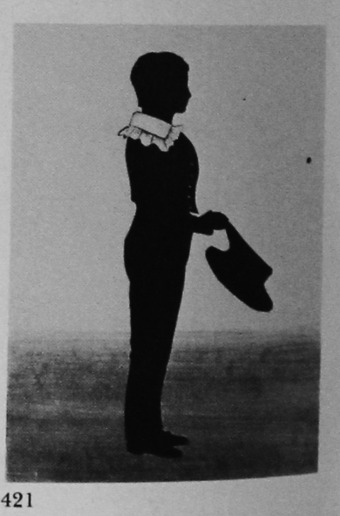
Unknown boy
Cut silhouette, mounted on salmon-pink paper
? Early 1830s
Trade Label No. 1
Crown Copyright. Victoria and Albert Museum No. E325-1947
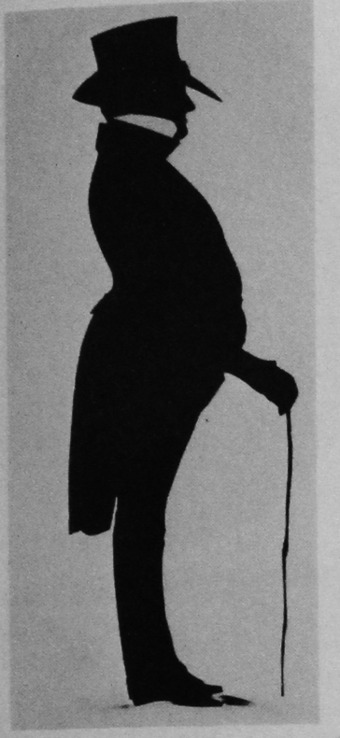
Unkwown man
Cut silhouette
Late 1830s or early 1840s
Trade Label No. 2
From E. Nevill Jackson, ‘The History of Silhouettes’ (1911), by courtesy of the ‘Connoisseur’
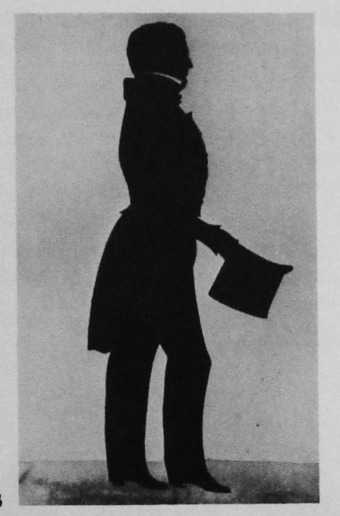
Unknown man
Cut silhouette, mounted on salmon-pink paper
1840-50
Painted on the marbled type of base which the artist favoured. The date is suggested by the subject’s military frock-coat; the top-hat (not very high in the crown) is also typical of the period.
From the collection of the late J. C. Woodiwiss
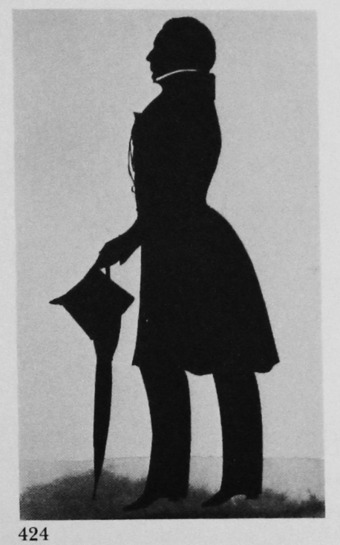
Unknown man
Cut silhouette, mounted on salmon-pink paper
Early 1850s
From the collection of the late J. C. Woodiwiss
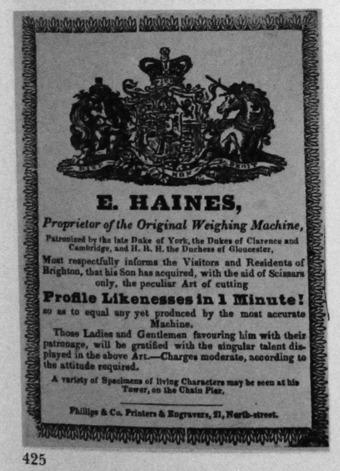
Trade Label No. 1 of Edward Haines, from the reverse of the silhouette illustrated in 421
Crown Copyright. Victoria and Albert Museum No. E325-1947
